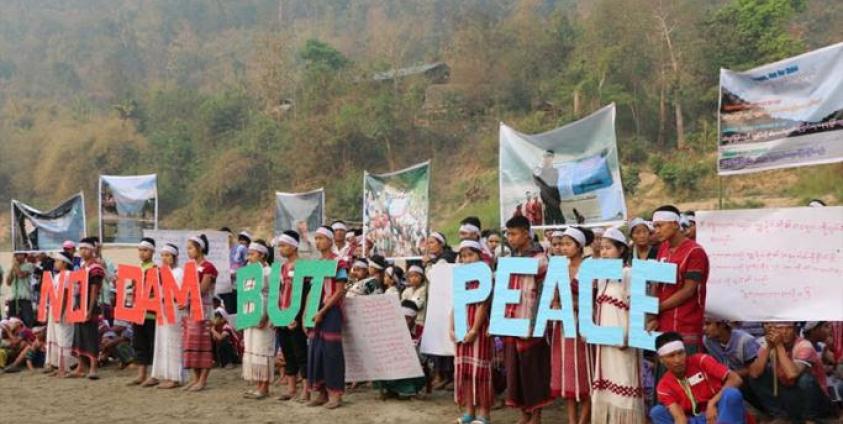This week on International Day of Action for Rivers, Karen Rivers Watch is demanding that all large dams planned and under construction on Myanmar's rivers are completely abandoned so that those most affected by civil-war can advance efforts to build lasting peace and a genuine democratic federal union.
The following is the Karen Rivers Watch Statement:
Large Dams are Driving Conflict, Not Empowering People to Build Peace
Today we gather on the banks of the mighty Salween to celebrate this river, the free-flowing lifeblood of our Karen people, and to demand that all proposals for the construction of large dams on our rivers are completely abandoned.
The Union government’s proposed Hatgyi dam on the Salween river threatens to flood and starve our ancestral territories, permanently displace us from our heritage, and inflame conflict and insecurity. For our Karen people the Hatgyi dam is a symbol violence and a tool used by the Burma Army to occupy our territory.
“In this time of so-called peace building, large dams like the Hatgyi project are driving conflict, uprooting people from their homes and indigenous territories, and forcing thousands to become IDPs and refugees”, stated Saw Tha Phoe, coordinator for Karen Rivers Watch.
In September 2016, armed conflict broke out along the eastern access road leading to the Hatgyi dam site in Lu Pleh Township, Hpa-an District (Hlaingbwe Tsp.), as the Burma Army-led Borer Guard Force (BGF) moved to assert military control over the dam site area. The fighting, which lasted for over two weeks, forced more than 5,000 people from 28 villages to flee their homes into an area under the control of the Burma Army and their BGF. Today, the many hundreds of families uprooted by the conflict continue to suffer in cramped shelters in Myaing Gyi Ngu town without access to adequate food, medicine or humanitarian support.
“I really want to go home but I don't dare to go back. We are afraid of the fighting. We came to take refuge in Myaing Gyi Ngu IDP area, but it is totally different from our village. We can't stay, eat or travel like we did in our villages. It is like we are living in a prison”, explained one woman interviewed by Karen Rivers Watch.
Those families forced into the Myaing Gyi Ngu IDP area face a struggle that has become all too common for ethnic people caught in Burma’s decades-long civil war. The Karen people at Ei Tu Hta IDP camp were forced to flee their ancestral territories in 2006 as the Tatmadaw’s military campaigns reached their villages. Located on Karen State’s border with Thailand, on the Salween River, communities like those at Ei Tu Hta have been all but forgotten as major cuts to humanitarian aid has left them without support, on a river that may be dammed, without a safe way to return home.
In Mutraw District (Papun), located upstream of the Hatgyi dam site in the direct path of the projected flood zone, indigenous Karen communities have been building a bold, bottom-up pathway to peace. Known as the Salween Peace Park, this initiative is guided by Karen culture and incorporates community-based conservation, decentralised energy projects and customary systems of land management. The Salween Peace Park aims to create a safe place for refugees and IDPs to return home and rebuild their livelihoods.
In the three years since the new government has taken office there has been little progress towards sustainable peace and a genuine democratic federal union. The focus of the union government has instead centered around attracting large-scale investments to advance resource intensive industries, such as large hydropower. Existing community-led governance systems, such as the Salween Peace Park, offer a path to peace and federal democracy built on the aspirations of communities most affected by civil-war.
We call for ethnic governance and natural resource management systems to be recognised at all levels of decision-making and administration. We also call on the Union Government and all investors to abandon their support for the Hatgyi dam, and all other large dams in Burma so that those most affected by civil-war can lead efforts to build lasting peace and a genuine democratic federal union.








